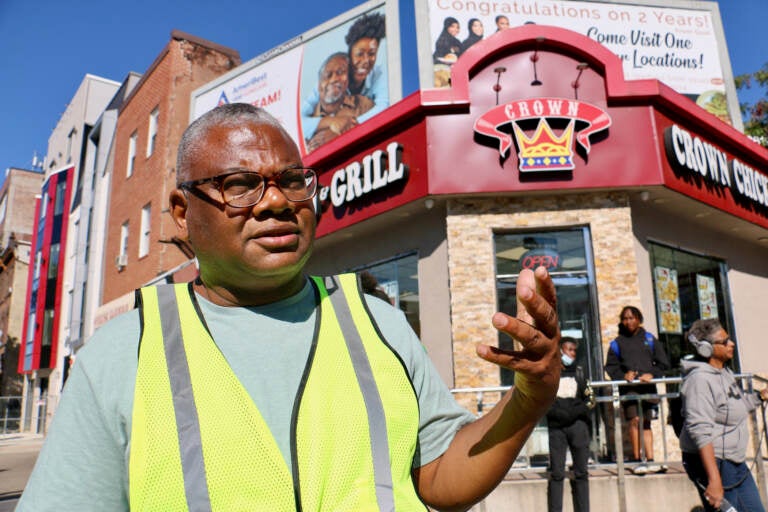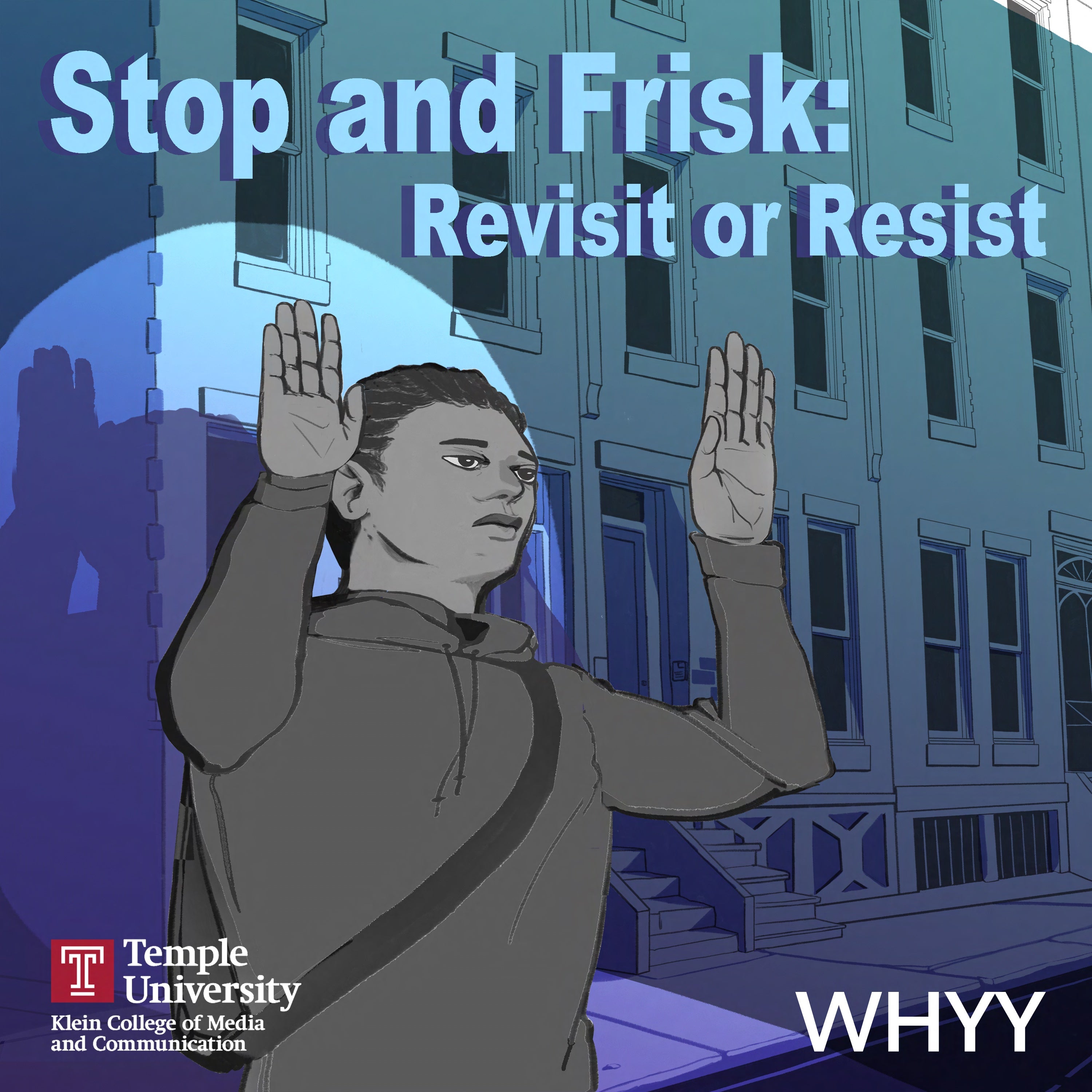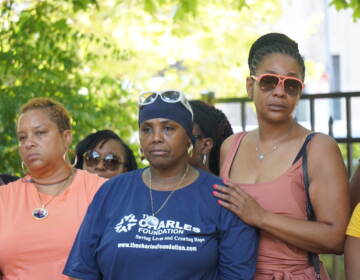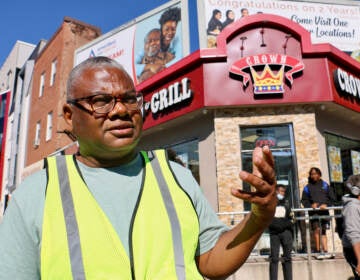Episode 1: How did we get here?
WHYY and Temple University collaborated on a podcast looking at the controversial policing practice stop and frisk. Episode 1 is “How Did We Get Here?”

Reuben Jones, founder of Frontline Dads, a youth mentoring program. keeps watch at the area around Broad and Susquehanna streets as students are dismissed from three nearby schools. (Emma Lee/WHYY)
This episode is from Stop and Frisk, a podcast production from WHYY News and Temple University’s Logan Center for Urban Investigative Reporting.
Find it on Apple Podcasts, Spotify, or wherever you get your podcasts.
-
Episode Transcript
SARAH GLOVER: HELLO. I’M SARAH GLOVER, WHYY’S VICE PRESIDENT OF NEWS AND CIVIC DIALOGUE. WHYY NEWS IS COMMITTED TO REPORTING ON SOLUTIONS TO PHILADELPHIA’S GUN VIOLENCE CRISIS. THIS PODCAST DIGS INTO THE CONVERSATION ABOUT STOP AND FRISK, GUN VIOLENCE, AND PUBLIC SAFETY IN THE CITY OF BROTHERLY LOVE. JOIN US AS WE TAKE AN IN DEPTH LOOK AT HOW WE GOT HERE. THIS IS A CONVERSATION PHILLY NEEDS TO HAVE.
SAMMY: BEFORE WE START: THIS EPISODE CONTAINS PROFANITY, DESCRIPTIONS OF POLICE BRUTALITY, RAPE AND MURDER.
MUSIC
YVONNE: IF YOU WANT TO KNOW WHAT IT’S LIKE TO BE STOPPED AND FRISKED IN PHILLY, ASK A BLACK MAN…
PAUL: I’m gonna give a metaphor. You’re a woman at a bar, a guy you don’t want to talk to. Starts touching on you. Because, the more heinous cops, cavity searches, touching your private parts, touching, you know it’s it’s just touching you at all. Strangers touching you. Forget they got a job or they’re a cop, right? Because they don’t have to do that. They choose to.
YVONNE: THIS IS AUDIO OF AN IPHONE RECORDING OF A POLICE STOP HERE IN PHILLY.
OFFICER: You got an ID?
CIVILIAN 1: What seems to be the problem?
OFFICER: You got an ID? You live around here?
CIVILIAN 1: No, not on me. I’m going to work
YVONNE: A BLACK MAN IS WALKING DOWN THE STREET, IT’S A BEAUTIFUL SUNNY DAY, AND THEN A COP CAR PULLS UP NEXT TO HIM. THE MAN’S FRIEND STARTS FILMING ON HIS IPHONE.
OFFICER: Alright, sitting down on that step?
CIVILIAN 1: No.
OFFICER: You know the guy that was sitting down there on that step putting his boots back on? Then why were you talking to him?
CIVILIAN 1: I was just saying hi to him.
OFFICER: Why? You don’t say hi to strangers.
CIVILIAN 1: Why not?
OFFICER: Not in this neighborhood.
YVONNE: WITHIN 30 SECONDS, THE TWO OFFICERS APPEAR TO GRAB THE MAN, FORCE HIS HANDS UP AGAINST THEIR COP CAR, AND START SEARCHING HIM.
OFFICER: I’ll kick your ass too.
OFFICER 2: Hey, get back here!
CIVILIAN 2: Why?
OFFICER 2: And put your phone in the pocket.
CIVILIAN 2: Why do I gotta put my phone in pocket? I didn’t do anything.
YVONNE: THEN ANOTHER OFFICER GRABS THE MAN WHO’S FILMING. HE DROPS HIS PHONE ON THE GROUND, AND THE IMAGE CUTS TO A SHOT OF JUST BLUE SKY.
CIVILIAN 2: I didn’t do nothing.
OFFICER 3: You’re under investigation right now.
CIVILIAN 2: Under investigation of what? I was walking.
OFFICER 3: Well that’s not what I saw.
MUSIC
SAMMY: SO LET’S HAVE THE CONVERSATION. I’M SAMMY CAIOLA, THE GUN VIOLENCE PREVENTION REPORTER AT WHYY.
YVONNE: AND I’M YVONNE LATTY, THE DIRECTOR OF TEMPLE UNIVERSITY’S, LOGAN CENTER FOR URBAN INVESTIGATIVE REPORTING.
SAMMY: AND THIS IS STOP AND FRISK: REVISIT OR RESIST, A PODCAST THAT LOOKS AT THE PUSH TO VISIBLY ENFORCE A CONTROVERSIAL POLICING METHOD … BECAUSE PHILLY’S BACK IS UP AGAINST THE WALL.
THIS IS EPISODE 1, HOW DID WE GET HERE?
YVONNE: IN 2022, WITH CITY CRIME STATS SHOWING PHILADELPHIA IN THE MIDST OF YET ANOTHER RECORD BREAKING YEAR OF MURDERS AND SHOOTINGS.
SOUND OF POLICE CARS
Newscaster 1: So far this year, 300 people have lost their lives due to gun violence in the city. That’s just four fewer than this time last year.
Newscaster 1: In a matter of hours, nearly ten people were shot. Three are fighting for their lives
YVONNE: STOP AND FRISK, THE CONTROVERSIAL POLICE TACTIC THAT SOME CONSIDER RACIALLY BIASED, IS BEING FLOATED AS A POSSIBLE SOLUTION TO GUN VIOLENCE IN PHILLY.
Councilmember Darrell Clarke: If there was a poll taken about stop and frisk, and stop and frisk was believed to be a tool towards fighting crime and stop people from carrying illegal guns. I think you might be surprised at the outcome of that particular poll.
SAMMY: THAT’S PHILLY CITY COUNCIL PRESIDENT DARRELL CLARKE AT A JULY CITY COUNCIL MEETING. HE’S A SELF DESCRIBED 6’3” BLACK MAN WHO KNOWS HE WOULD FIT THE BILL OF A TYPICAL STOP AND FRISK SUSPECT… BLACK MEN.
Clarke: I’ll take this suit off and I’m walking down Cecil B Moore Avenue and I’m likely to be stopped. I’m likely to have a cop look at me two, three times. Right? That’s reality.
YVONNE: A FEW BLACK AND BROWN NEIGHBORHOODS BEAR THE BRUNT OF THE SKYROCKETING GUN VIOLENCE.
AND THEY ARE SO TIRED OF THE FEAR, THE TRAGEDY, THE SENSELESS DEATHS AND SHOOTINGS THAT HAVE BEEN STEADY SINCE COVID-19 SHUT US ALL INDOORS AND THEN RELEASED US INTO THIS VIOLENT NEW WORLD.
MUSIC
Joyce: My nephew was killed two months ago with gun violence. And so I’m just over it. I’m just so over it.
Speaker 2: I just had a girl that I grew up with and her son just got murdered. It’s the trauma of every day. This gun violence is crazy and it’s making people crazy and it’s traumatizing people. Like you don’t want to be out when the sun is down. You shouldn’t have to live like that. It’s absolutely ridiculous.
Abdul: II had a, a cousin who was eight months pregnant, went away to see her, uh, her doctor. This was up in the North Philadelphia area. On her way out, she was dragged into an abandoned building by gunpoint and was raped and then shot in the head twice. Left for dead. She died.
Clarke: You can’t have an environment where everybody is carrying a gun, an illegal gun. So let’s have the conversation. Let’s have real people involved in that conversation. Let’s figure out what we’re going to do.
YVONNE: IN 2021, POLICE REPORTED A RECORD SETTING 562 HOMICIDES. EIGHTY PERCENT OF THOSE VICTIMS WERE BLACK. EIGHT-NINE PERCENT OF THOSE MURDERS INVOLVED A GUN.
THINK ABOUT IT. TWO THOUSAND THREE HUNDRED AND THIRTY PEOPLE WERE SHOT. THAT’S MORE THAN TWO THOUSAND THREE HUNDRED AND THIRTY FATHERS, MOTHERS, SONS, DAUGHTERS, SIBLINGS AND FRIENDS…
SHOOTINGS WERE UP FOUR PERCENT FROM THE PREVIOUS YEAR.
SAMMY: IN 2022, WE’RE ON A SIMILAR TRACK. GUN VIOLENCE HAS HIT PRACTICALLY EVERY NEIGHBORHOOD.
YVONNE: EVEN AT OUR WELCOME AMERICA FESTIVAL, PHILLY’S BIG FOURTH OF JULY CELEBRATION THAT ENDS WITH A CONCERT THAT HAS THOUSANDS OF VISITORS AND LOCALS DANCING AND SINGING ON THE PARKWAY…
AUDIO OF THE INCIDENT
…EVEN THAT WAS MARRED BY BULLETS. AS THE FIREWORKS EXPLODED, SHOTS WERE FIRED, SOME SAY IN CELEBRATION, BUT IT’S NOT REALLY CLEAR. PEOPLE RAN FOR THEIR LIVES. TWO OFFICERS WERE STRUCK BY STRAY BULLETS.
SAMMY: IT’S ALWAYS BIG NEWS WHEN VIOLENCE STRIKES AT MAJOR CITY EVENTS, BUT IN A LOT OF PHILLY NEIGHBORHOODS, THAT’S JUST A NORMAL WEEKEND. SOME WEEKENDS THERE ARE MORE THAN TWO DOZEN SHOOTINGS ACROSS THE CITY.
Newscaster: Two people are dead and at least twenty others shot, including a two-year old boy. He was shot once in the back.
SAMMY: MOST SHOOTINGS OCCUR ON JUST 57 BLOCKS, ACCORDING TO THE ROBERT WOOD JOHNSON FOUNDATION. ON THOSE BLIGHTED STREETS THE POVERTY RATE IS TWICE AS HIGH AND LIFE EXPECTANCY CAN BE AS MUCH AS 20 YEARS SHORTER.
YVONNE: AND A BIG DRIVING FACTOR IN THE UPTICK IN SHOOTINGS IS THE PROLIFERATION OF GUNS, MANY OF THEM ILLEGAL. AND SO A QUESTION THAT’S COMING UP MORE AND MORE IN 2022, AMONG POLICE AND POLITICIANS, BUT ALSO COMMUNITY MEMBERS IN THE MOST AFFECTED NEIGHBORHOODS… IS THE ANSWER TO THIS HORROR, STOP AND FRISK 3.0?
MUSIC
YVONNE: STOP AND FRISK IS A CATCH-ALL TERM FOR A TYPE OF POLICE STOP. SINCE 1968, POLICE HAVE HAD THE POWER TO STOP ANYONE THEY CLAIM THEY HAVE REASONABLE SUSPICION TO BELIEVE HAS COMMITTED A CRIME, OR IS ABOUT TO. AND THEY CAN FRISK, OR SEARCH, THEM FOR GUNS AND CONTRABAND.
IT’S BEEN USED WITH GUSTO BY POLICE DEPARTMENTS AROUND THE U.S, PARTICULARLY IN PLACES LIKE NEW YORK AND PHILLY. ACCORDING TO LAW EXPERTS, PHILADELPHIA HAS USED STOP AND FRISK MORE THAN ANY OTHER CITY.
SAMMY: THE DANGER OF STOP AND FRISK OF COURSE, IS THAT IT GIVES POLICE NEAR TOTAL DISCRETION TO STOP ANYONE THEY WANT.
CRITICS SAY IT’S A VERY PURE FORM OF RACIAL PROFILING. YOU STOP WHO YOU THINK IS MOST LIKELY TO BE UP TO NO GOOD… WITH ALL THE BIAS THAT ENTAILS.
YVONNE: THE DATA SHOWS THIS CLEARLY. IN 2009, CLOSE TO 90 PERCENT OF PEOPLE STOPPED IN PHILLY WERE BLACK OR LATINO.
David Rudovsky: What we’ve found consistently for ten years was that there was a significantly higher number of Black persons stopped without reasonable suspicion than whites, which to us meant the threshold for stopping a Black was lower than it was for a white person.
SAMMY: THAT’S DAVID RUDOVSKSY, A CIVIL RIGHTS ATTORNEY WHO SUCCESSFULLY ARGUED A CHALLENGE TO PHILADELPHIA STOP AND FRISK IN 2010.
David: Same kind of conduct between the two: you stopped a Black person, not the white person.
SAMMY: AND OFTEN, WHAT THEY WERE STOPPED FOR WAS NOTHING SERIOUS
David: 30, 40% of the stops were minor quality of life stuff. Somebody urinating in an alley, somebody with an open liquor container, smell of marijuana. Three kids on a corner, you know.
SAMMY: EVEN THOUGH GETTING ILLEGAL GUNS OFF THE STREETS WAS OFTEN THE STATED GOAL, RUDOVSKY SAYS OFFICERS RARELY FOUND FIREARMS
SO HE AND THE ACLU FILED A FEDERAL CLASS ACTION LAWSUIT. IT LED TO A SETTLEMENT, WHAT’S KNOWN AS THE BAILEY AGREEMENT.
David: They would retrain their officers to make sure that officers were stopping only on reasonable suspicion, as the Supreme Court had defineD it. And they agreed that there cannot be racial bias.
SAMMY: THE SUPREME COURT ESSENTIALLY RULED THAT STOP AND FRISK IS CONSTITUTIONAL, BUT OFFICERS HAD TO HAVE REASONABLE SUSPICION. IT’S A NOTORIOUSLY VAGUE STANDARD TO MEET.
SO STOP AND FRISK NEVER REALLY WENT AWAY, IT JUST CHANGED.
David: A lot of people think it ended. Right. You know, and that’s why we’ve got this surge in murders. It’s just, that’s just not true.
SAMMY: BECAUSE OF THE BAILEY AGREEMENT, THE POLICE ALSO HAD TO START TRACKING THEIR STOPS IN AN ELECTRONIC DATABASE, TO DOCUMENT WHETHER RACE WAS PLAYING A ROLE.
THAT DATA SHOWS THAT BETWEEN 2010 AND 2017, THE RATE OF FRISKS WAS CUT IN HALF. AND STOPS DID START YIELDING MORE GUNS: IN THE FIRST QUARTER OF 2022, ABOUT 5% OF STOPS AND 8% OF FRISKS RESULTED IN SEIZURE OF A FIREARM. BUT THE RACIAL DYNAMICS STAYED THE SAME.
SAMMY: IN THE SECOND HALF OF 2019 BLACK PHILADELPHIANS MADE UP 71 PERCENT OF STOPS, BUT WERE JUST 44 PERCENT OF THE POPULATION. THERE HAVE BEEN A FEW ATTEMPTS TO MAKE STOP AND FRISK MORE PALATABLE, MORE TARGETED, LESS RACIALLY MOTIVATED. THIS SOMETIMES GETS REFERRED TO AS “CONSTITUTIONAL STOP AND FRISK.”
RUDOVSKY SAYS THAT’S WHAT HE BELIEVES CLARKE WAS PUSHING WHEN HE BROUGHT UP STOP AND FRISK IN JULY… MORE STOPS, BUT WITH MORE ACCOUNTABILITY.
David: He would say, I’m not saying go back to the old days. Right. I’m not saying do it racially biased, but it’s an effective police tool that’s used, and if we have to use it more, let’s use it more.
YVONNE: BUT IN THE PAST FEW YEARS, THE DANGER OF STOP AND FRISK, AND POLICE STOPS IN GENERAL, HAS BECOME ALL TOO CLEAR.
SOUNDS OF GUNSHOTS, OFFICERS YELLING.
YVONNE: STOP AND FRISK LIVES UNDER A BROAD TENT OF POLICING TACTICS CALLED TERRY STOPS – ESSENTIALLY ANY TIME THE POLICE STOP YOU OUT OF SUSPICION, WHETHER ON FOOT, IN A CAR, WHEREVER. THESE STOPS HAVE LED TO POLICE SHOOTINGS AND THE DEATH OF BLACK MEN THROUGHOUT THE COUNTRY. WHETHER YOU CALL IT STOP AND FRISK, A TERRY STOP OR A TRAFFIC STOP, THE TACTIC HAS KILLED BLACK MEN.
YVONNE: JUST OVER THE SUMMER JAYLAND WALKER OF AKRON, OHIO WAS SHOT 46 TIMES DURING A TRAFFIC STOP THAT TURNED DEADLY.
MUSIC
YVONNE: TERRY STOPS LED TO THE DEATHS OF MICHAEL BROWN IN FERGUSON, FREDDY GRAY IN BALTIMORE AND ERIC GARNER IN NEW YORK CITY.
CHANTS OF “HANDS UP, DON’T SHOOT”
YVONNE: THEIR DEATHS LED TO NATIONWIDE PROTESTS AND CRIES FOR POLICE REFORM.
CHANTS OF “WHOSE STREETS? OUR STREETS.”
YVONNE: MANY THOUGHT THAT ALL THESE HIGH-PROFILE DEATHS AT THE HANDS OF POLICE WOULD LEAD TO BROAD REFORMS… AND CHANGES DID COME TO PHILLY.
PHILADELPHIA CITY COUNCIL PASSED A NEW LAW IN EFFECT THIS YEAR, WHICH MAKES IT ILLEGAL FOR POLICE OFFICERS TO STOP DRIVERS FOR A BROKEN TAILLIGHT, AN EXPIRED OR MISSING LICENSE PLATE OR OTHER MINOR VIOLATIONS.
HERE’S CITY COUNCILMEMBER ISIAH THOMAS WHO LED THE EFFORT.
Isaiah Thomas: There are ways that we can govern and advocate for communities of color and not be anti-anything. Right? This isn’t anti-police, we’re developing more trust between communities of color and law enforcement.
MUSIC
SAMMY: SO ON THE ONE HAND, THE CITY HAS TAKEN STEPS TO REDUCE POLICE STOPS, ACKNOWLEDGING THAT THESE STOPS CAN BE UNNECESSARY, DISCRIMINATORY AND EVEN DANGEROUS FOR BLACK MEN.
BUT WITH SHOOTINGS ON THE RISE, SOME PEOPLE LIVING WITH THE INCREASED VIOLENCE – MANY OF THEM BLACK THEMSELVES – ARE SAYING THEY WANT POLICE TO DO MORE.
MUSIC
SAMMY: AND OTHERS TELL ME THEY FEEL SAFER WITHOUT THE POLICE AROUND, OR THAT THEY DON’T THINK MORE POLICING WOULD HELP.
AD: SUPPORTING WHYY, PENN MEDICINE’S TRANSPLANT INSTITUTE. PERFORMING KIDNEY, LIVER, HEART, LUNG, AND PANCREAS TRANSPLANTS FOR MORE THAN FIFTY YEARS. LEARN MORE AT PENNMEDICINE.ORG/TRANSPLANT OR 800-789-PENN.
SO, I MODERATED A COMMUNITY MEETING IN GRAYS FERRY, TO TRY AND UNDERSTAND ALL THE SIDES OF THIS DEBATE.
Tyrique Glasgow: My name is Tyrique Glasgow. I’m the executive director of Young Chances Foundation. It’s a community based organization, we work out of Grays Ferry.
YVONNE: SAMMY INVITED ME AND A FEW TEMPLE UNIVERSITY STUDENTS TO THIS COMMUNITY EVENT, A CONVERSATION IN A CHURCH GYM IN THE 17TH POLICE DISTRICT, WHICH COVERS GRAYS FERRY, A WORKING CLASS SOUTH PHILLY NEIGHBORHOOD.
GUN VIOLENCE HAS NOT BEEN AS DIRE HERE AS IN OTHER PARTS OF THE CITY – 31 SHOOTINGS THERE THIS YEAR, COMPARED TO 63 IN 2020. AND SOME RESIDENTS SEEM TO THINK THAT HAS TO DO WITH BETTER POLICING.
THE POLICE HERE HOLD A LOT OF COMMUNITY EVENTS WHERE THEY INTERACT WITH KIDS AND OTHERS IN THE COMMUNITY, AND THAT’S LED TO A SENSE THAT THEY’RE A POSITIVE PRESENCE.
Tyrique: One of the things that the police department has done over the last two years has dropped a lot of the crime.
SAMMY: WE’RE IN A BIG GREEN CATHOLIC SCHOOL GYM, WITH ABOUT 50 TO 75 ATTENDEES, MOSTLY WOMEN, KIDS, AND MIDDLE AGED MEN AND OLDER MEN. POLICE REPRESENTATIVES AND COMMUNITY GROUPS HAVE TABLES OFFERING SERVICES.
Andre Ford: Our mission is to serve as a liaison between the community and the police, to reduce fear and incidence of crime and enhance the quality of life within our community.
SAMMY: HERE’S ANDRE FORD, PRESIDENT OF THE 17TH POLICE DISTRICT ADVISORY COUNCIL.
Ford: Our goal is to create lasting change through sustainable programs and resources. We are here to bring that voice to the police on issues that’s going on in our community. Please come out and join. In this way your voice is being heard.
SAMMY: THERE’S A LOT OF COMMUNITY LEADERS EAGER TO TAKE THE MIC, LIKE WALI SMITH OF THE PHILADELPHIA ANTI-DRUG ANTI-VIOLENCE NETWORK.
Wali Smith: We have reduced violence in this district. We had a few shootings lately, but we, we really on top of it. So we want to make sure it doesn’t get heated. So we do a lot of conflict resolution. I love South Philly and I love not seeing our young people kill each other.
SAMMY: AND COMMUNITY LEADER CHARLES REED.
Charles Reed: I want to start out by saying how proud I am of the young people in my community. We haven’t had a shooting or killing in like six months. And that’s a great thing. So when you see my kids, pat him on the back and tell them we love them, right?
YVONNE: DESPITE MANY OPTIMISTIC SPEAKERS, CLAIMING THAT BETTER POLICE RELATIONS HAVE RESULTED IN FEWER SHOOTINGS, THE CHATTER AMONG SOME RESIDENTS IS THEY WANT POLICE TO DO EVEN MORE… THEY WANT TO SEE A KINDER, GENTLER STOP AND FRISK VISIBLY ENFORCED.
Joyce: These young kids out here. They don’t have anything to do. So I think, yeah, it can be a solution.
Speaker 2: Yes. Because right now is so many young teenagers, that’s walking around carrying guns and that’s who’s committing most of the crimes.
Al: We could write a law that allows stop and frisk as long as the person just goes. We take the gun. Nobody is hurt. And that’s it. So please consider that.
YVONNE: BUT THEN, REUBEN JONES GETS UP.
Rueben Jones: But let me just warn you that sometimes you get what you ask for, right? We all want to see the gun violence end. But stop and frisk is not the way to do that.
YVONNE: JONES IS A LONGTIME COMMUNITY ACTIVIST WHO LEADS FRONTLINE DADS, A MENTORING PROGRAM FOR YOUNG PEOPLE FROM CHALLENGED BACKGROUNDS.
HE’S A FATHER, SOCIAL JUSTICE ADVOCATE, EDUCATOR, AUTHOR AND A PHILLY NATIVE WHO SPENT 15 YEARS IN PRISON. WHEN HE SPEAKS, PEOPLE LISTEN.
Reuben: They haven’t done a real good job of finding guns in these stop and searches.What they found was Black men who are on probation or parole who end up getting violated, you know, and sent back to jail basically without committing a crime.
So if you working and if you got children and you got a family and now all that’s disrupted because a police officer pulled you over on the corner of your block and said come here and found some weed on you, you know, they whatever. But very few times have they actually found guns. I just want to clear the air about that, about it just being ineffective. Number 2 is it specifically targets Black men
Sammy Caiola: I know you work daily with young men in your community. How do they feel about the police? Do they have any trust? How much fear do they have? What are their concerns?
Rueben: The young black men that I work with who most of whom have been shot or lost, a family member or friend to gun violence, has suffered some trauma in their lives growing up, and then have this distrust of police because of they history. Philadelphia has a volatile history of police relationships with black men.
MUSIC
Reuben: We can’t dismiss it and say, you know, that’s not valid. I’m a good guy or my uncle was a cop or whatever. Like, who cares? If this young man is saying I’ve been violated, or I saw my father or my uncle or my brother violated, that’s real. So what we need is police officers who can sit down with folks and look them in the eye. Right. Say, look, I ain’t one of them. I’m here to serve you. I’m here to protect you. I’m here to work with you, within the community, and then folks can work together in a collaborative way to keep this community safe.
YVONNE: THE THING ABOUT THIS MEETING… THERE WEREN’T A LOT OF YOUNG MEN THERE, NOT THE YOUNG MEN THAT REUBEN JONES WORKS WITH, WHO ARE MOST LIKELY TO BE PERPETRATORS AND VICTIMS OF THE VIOLENCE. SO THERE WAS A LOT OF TALK ABOUT THEM, BUT NOT WITH THEM.
SAMMY: JONES SPENDS A LOT OF TIME WITH THOSE YOUNG MEN. THAT’S PART OF WHY HE’S AGAINST STOP AND FRISK. BUT HE DOES THINK POLICE HAVE A ROLE TO PLAY, AND THEY’RE FAILING AT IT. WITH SO FEW OFFICERS IN SOME OF THE CITY’S TOUGHEST STREETS, JONES AND HIS ORGANIZATION HAVE BEEN FILLING IN THE GAPS.
SOUNDS FROM A CROWD
SAMMY: SO YVONNE AND I GO VISIT JONES AT BUSY BROAD STREET AND SUSQUEHANNA IN NORTH PHILADELPHIA. HE AND AND A FEW OTHER BLACK MEN COME HERE EVERY DAY, IN NEON GREEN VESTS TO KEEP AN EYE OUT FOR THE TEENS WHO ARE COMING HOME FROM SCHOOL.
Paul Jackson: So you can see, we got speeders. We have no crossing guards at a corner where, we’re the crossing guards, basically.
SAMMY: THAT’S PAUL JACKSON, HE’S A FRONTLINE DAD PEACE AMBASSADOR. THEY HAVE AN OFFICE ON NORTH BROAD STREET WHERE THEY PROVIDE SPACE FOR TEENS TO HANG OUT, AND AT SCHOOL DISMISSAL TIME, THE AMBASSADORS HIT THE STREETS.
Paul: There’s barely any police presence to watch out for people who are selling drugs or are fighting somewhere. And there’s hundreds and thousands of youth that pass this spot between 2:30 and 5:00 to catch the train and buses, many buses pull up on these corners, so you know.
YVONNE: ONCE THE KIDS SCATTER HOME, JONES AND JACKSON WALK US THROUGH ONE OF THE 57 MOST DANGEROUS BLOCKS IN PHILADELPHIA, THE 1800 BLOCK OF SUSQUEHANNA AVENUE, JUST A FEW BLOCKS WEST OF TEMPLE’S CAMPUS.
THERE’S AN EMPTY LOT THAT HAS TURNED INTO A TRASH DUMP. FLIES SWARM AND THE OVERPOWERING SMELL OF GARBAGE HITS YOUR NOSE. THERE’S TRASH EVERYWHERE… ON THE SIDEWALKS AND STREETS.
TOO MANY STORES ARE LONG SHUT FOR GOOD. CRACKS ALL OVER THE UNEVEN SIDEWALKS. MEN WITH BEER IN BROWN BAGS AND FOLKS ON THE STOOP TAKE IT ALL IN. OR AS PAUL WOULD DESCRIBE IT…
Paul: An amazingly historic black neighborhood that’s filled with organizations and community affairs and historic buildings, and also a under-served redlined, gerrymandered ghetto that’s full of crime, killing, drugs, despair, prostitution, and a lot of anger. So it’s your classic East Coast Black neighborhood. It’s your classic Brooklyn, a classic, you know, west side of Baltimore. It’s a lot of institutionally-created problems of racism and classism. You see it every day. A lot of drunkenness on some of the corners, a lot of drug sales and addicts. But again, a proud, strong, largely Black neighborhood with a lot of children living out here.
YVONNE: WE WALK BY WHERE JUST A FEW MONTHS AGO, 15-YEAR-OLD JUAN CARLOS ROBLES-CORONA JR. WAS MURDERED ON HIS WAY HOME FROM SCHOOL.
Paul: He was murdered right here, right here in this neighborhood. And almost his whole school came out. The neighborhood came out and had multiple vigils for him right along this gate. It was covered on his actual altar. His, um, I’m gonna call it a shrine.
YVONNE: GUN VIOLENCE IS RAMPANT HERE. THERE WERE TWELVE SHOOTINGS ON SUSQUEHANNA BETWEEN BROAD AND 20TH THIS YEAR – TWO OF THEM FATAL.
THE BLOCK SITS IN THE 22ND DISTRICT. THERE WERE 228 PEOPLE SHOT AS OF OCT. 20th, MORE THAN ANY OTHER DISTRICT IN THE CITY EXCEPT THE 24TH. IN 2021, THE DISTRICT HAD MORE SHOOTING VICTIMS THAN ANY OTHER.
Paul: This is one of the epicenters. This is one of the epicenters, lower North Philly. Lots of gun violence, a lot of guns, a lot of traumatizing gunshots every night, on some Palestine, PTSD, stuff going on out here.
YVONNE: SINCE 2014, POLICE MADE 178,000 STOPS IN THIS NORTH PHILLY NEIGHBORHOOD ALONE. THAT MEANS 22,250 STOPS PER YEAR ON AVERAGE.
AND SINCE THE START OF THE PANDEMIC, THAT NUMBER HAS GONE DOWN.
STILL, IT’S MORE THAN THREE TIMES AS MANY STOPS AS IN CENTER CITY’S WHITER, WEALTHIER 9TH DISTRICT DURING THE SAME PERIOD.
JONES SAYS GUN VIOLENCE SOLUTIONS THAT DO NOT INVOLVE STOP AND FRISK CAN BE FOUND IF PEOPLE IN POWER JUST LISTEN TO THOSE WHO ARE LIVING WITH THESE THREATS EVERY DAY.
Reuben: Back in the summer the youth came up with some great solutions on their own to like raising the age of getting a gun license, making you have to get a mental health treatment to qualify for a gun license, like all these things that make sense, right? These people can tell you what’s best for their lives and what’s happened to them and what they need and what they’ve been through, you know. It’s not a mythological black unicorn, you know what I’m saying? You know that if we can get to the heart of those stories and humanize people. And so I’ll talk about how violence impacts them and the ideas and solutions they have to address it, then we start to change the narrative.
SAMMY: THOUGH THE NARRATIVE OF THIS STREET IS DARK, PEOPLE DO LIVE HERE. DANCE MUSIC BLASTS FROM A LOT WHERE NEIGHBORS GATHER FOR A GRILL-OUT.
YVONNE: Uh oh, everyone is dancing now. (Laughs) Oh, gosh. Here we go. It’s. It’s a dance party now.
SAMMY: WE MEET A MOM WITH A TODDLER SITTING ON A CHAIR ON THE SIDEWALK ENJOYING THIS WARM FALL DAY.
Ruben: What’s your name?
Tyshea: Tyshea.
Reuben: Tyshea. I’m Ruben.
SHE SAYS SHE NEVER SEES THE POLICE, WHICH IS A GOOD THING IN HER EYES.
Tyshea: They don’t do nothing. They mean.
SAMMY: FOR TYSHEA, THERE IS NO BETTER NEIGHBORHOOD THAN HER BLOCK.
Tyshea: Oh, I love my hood. We lit. (Laughs) My hood lit, I love my whole hood, like.
Reuben: What’s funny is it’s confusing because you hear people saying, my neighborhood is safe. I don’t see the police. Not a lot of gunshot. But we see the news reports and we see the data and it’s on the 57 block list. But then people have a different perception of it, you know what I mean?
YVONNE: Why do you think that is?
Reuben: I don’t know. I think the one thing is definitions like when she said we don’t see the police that much, but I’m glad because when they come around, they kill us.
MUSIC
SAMMY: IN EPISODE 2 OF STOP AND FRISK: REVISIT OR RESIST… THE TARGETS. WE’LL TALK TO YOUNG BLACK MEN WHO HAVE THE MOST AT STAKE.
Speaker 4: They’re not killing white people. They killing Black men for no reason. So with stop and frisk, you’re going to give them more opportunity to just stop and frisk and kill us?
SAMMY: PHILLY STOP AND FRISK: REVISIT OR RESIST IS A PRODUCTION OF WHYY AND TEMPLE UNIVERSITY’S LOGAN CENTER FOR URBAN INVESTIGATIVE REPORTING. I AM SAMMMY CAIOLA, COHOST, PRODUCER AND WHYY’S GUN VIOLENCE PREVENTION REPORTER.
YVONNE: AND I AM CO-HOST AND PRODUCER YVONNE LATTY, THE DIRECTOR OF TEMPLE’S LOGAN CENTER. OUR EXECUTIVE PRODUCER IS SARAH GLOVER, WHYY’S VP OF NEWS AND CIVIC DIALOGUE. OUR EDITOR IS JORDAN GASS-POORE. MUSIC IS BY EMIR MATOUK.
OUR ENGINEERS ARE AL BANKS AND DIANA MARTINEZ .
SAMMY: OUR PRODUCTION ASSISTANTS ARE NATHALY SUQUINAQUA, BRIAN MENGINI, AND EDITH MWANGI. SPECIAL THANKS TO JIM MACMILLAN AT THE PHILADELPHIA CENTER FOR GUN VIOLENCE REPORTING, FRONTLINE DADS, YOUNG CHANCES FOUNDATION.
YVONNE: PLEASE RATE AND REVIEW WHEREVER YOU ARE LISTENING. HIT US UP ON SOCIAL MEDIA. WE WANT TO HEAR FROM YOU. CHECK OUT OUR GUN VIOLENCE PREVENTION STORIES AND SOLUTIONS ON WHYY.ORG AND TEMPLELOGANCENTER.ORG. PLEASE JOIN US IN THIS CONVERSATION, AND THANKS FOR LISTENING.
collapse
“Stop and Frisk: Revisit or Resist,” a podcast produced by WHYY and Temple University’s Logan Center for Urban Investigative Reporting at the Klein College of Media and Communication, looks at how the controversial policing practice has reentered discussions about public safety in light of Philadelphia’s ongoing gun violence crisis.
Since 1968, police officers have been legally permitted to stop people they reasonably suspect are committing, are about to commit, or have just committed a crime, and search people who they believe are armed and dangerous. Analyses of Philadelphia stops show the practice, commonly referred to as stop and frisk, has been disproportionately used to detain Black and Brown men, often without justification and rarely leading to the confiscation of illegal firearms. The Philadelphia Police Department drastically decreased its use of stop and frisk in recent years, according to PPD data.
Now, a sense of fear and stress among some residents has led to calls for more drastic law enforcement action. Learn more about the community conversation in part one of the podcast, “How did we get here?”

Stop and Frisk: Revisit or Resist
Explore diverse perspectives and solutions to Philly’s gun violence crisis. Could beefing up this controversial police tactic help keep the city safe?
WHYY is your source for fact-based, in-depth journalism and information. As a nonprofit organization, we rely on financial support from readers like you. Please give today.
Brought to you by Stop and Frisk: Revisit or Resist

Gun violence in 2022: 500+ homicides, prevention efforts, and public safety
2022 was another challenging year for the communities most affected by Philadelphia gun violence.
3 years ago
The conversation about stop and frisk centers on Black and brown men. What about Black women and co-victims of violence?
3 years ago
57 blocks in Philly are prone to shootings. Community groups are mobilizing to curb the gun violence
The “57 Blocks Project” wants to create positive change in neighborhoods most impacted by violence. There are already dozens of nonprofits working in these areas.
3 years ago






